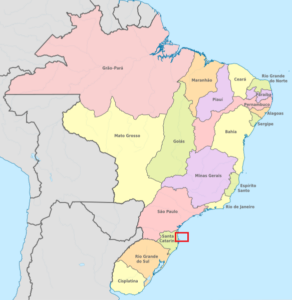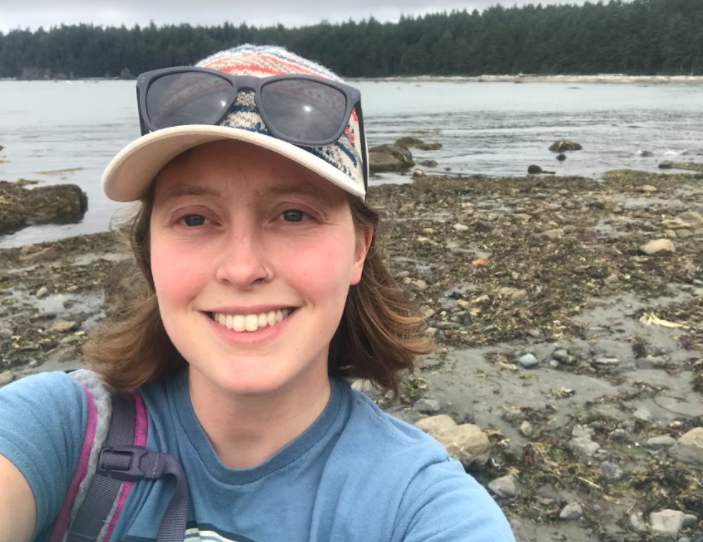Citation: Crivellaro, M.S., Candido, D.V., Lima Silveira T.C., Carvalhal Fonseca A., Segal, B. (2022) A tool for a race against time: Dispersal simulations to support ongoing monitoring program of the invasive coral Tubastraea coccinea. Mar. Pol. Bulletin, 185. ISSN 0025-326X.
Tracking and treating an invasive species problem is a gargantuan task, not unlike tracking a pandemic.
As modern society becomes increasingly globalized and interconnected, plants, animals, and diseases are easily spread from one part of the world to another, oftentimes under our noses and completely by accident. Customs services work to keep agricultural pests and human diseases from arriving in new areas, but marine invasive species often dodge these types of checks, going unnoticed until they start causing problems for native ecosystems and the people who rely on them.
Beautiful, But Destructive
Sun corals (Tubastraea coccinea) are one example of a devastating invasive species. They are popular in aquariums for their bright yellow and orange coloring, where they go by cheery names like sunflower coral, orange cup coral, and sun polyps. Native to the tropical Pacific and Indian oceans, these corals have spread to every ocean basin in the world except for Antarctica in only a few decades.

Compared to other corals, sun corals are quite unique. They are non-reef building corals and don’t host photosynthetic algae. This means that sun corals can inhabit deep water, while most other corals require sunny shallow water for their symbionts. Their ability to live nearly anywhere allows them to colonize deep water and to live on many kinds of surfaces, including metal. They also have no problem living in sunny, shallow water and can quickly displace native reefs in places like the Caribbean and Canary Islands. Removal of sun corals is tricky and labor-intensive due to their ability to thrive in dark crevices and deep water and their ability to regenerate quickly. This quick regeneration ability also allows them to take over native coral reefs.
Sun corals were first introduced to the Gulf of Mexico in 1945, and had spread throughout the Caribbean and western Atlantic by the 1980s. The spread of sun coral in the Atlantic has been highly correlated with the oil and gas industry, as the tiny coral polyps can hitch rides on oil rig platforms which are transported between the Indo-Pacific and the Gulf of Mexico. Brazil is one of the most affected countries by this species due to the expansion of offshore drilling off their coastline. The Brazilian government launched a National Prevention Plan for Control and Monitoring (NPPCM) for sun corals in 2018.
There are two facets to this plan: removal and monitoring. Removal is important for minimizing the spread of sun corals and for allowing affected ecosystems to recover, while monitoring is important for assessing which areas are at risk and for catching new sun coral populations before they become established. Because resources for managing this tricky invasive species are limited, the Brazilian government must be strategic about where they direct their efforts along Brazil’s expansive coastline and removal is often prioritized over monitoring.
A Race Against Time

To make monitoring more efficient, a team of Brazilian researchers used a common type of computer simulation model called IBM (Individual-based Models) to simulate the spread of sun corals from affected areas into pristine areas in southern Brazil. Their goal was to figure out where monitoring efforts would be most effective so that local agencies in Santa Catarina could prioritize. Part of their study area included the marine protected area, Rebio Arvoredo, and the nearby Arvoredo Island which is infected with sun corals.
Among the hundreds of types of simulation models available, the researchers settled on IBMs for the tool’s popular application in predicting disasters like oil spills and the dispersal of other invasive species. They also used IBMs to rewind time, investigating where oil rigs may have introduced sun corals and how often, to address the link between sun coral invasion and the expansion of the oil and gas industry in the region.
The researchers simulated a forecast of five new areas which were likely to be colonized by sun corals, one of which had never been included in any NPPCM monitoring plans. They also performed a “hindcast” simulation, or a look into the past, and discovered it was unlikely that sun corals colonized the Brazilian coastline from offshore oil rigs directly. The rigs were too far offshore and currents were not favorable to bring sun coral larvae into shore. However, the regular back-and-forth of supply ships between the oil rigs and the coast was a likely method of introduction.
The researchers hope to develop their forecasting tool into an easy-to-use app, which could be used by local natural resource agencies and communities to prioritize monitoring and removal tactics depending on the app’s built-in forecasting and risk assessment tools. They also warn of repeated introductions by oil rig supply ships and what the proposed expansion of this industry in their region could mean for sun coral management efforts in southern Brazil.
As global trade continues to introduce invasive species to ecosystems around the world, climate change adds extra ecological pressure in the form of marine heatwaves, increased storms, and other challenges. Environmental management agencies and researchers have the daunting task of managing these issues for the sake of their communities and future generations. Computational tools like these are exciting approaches to solving these daunting problems because they can be made to be immediately usable by the groups who need them.

I am a PhD student at the University of Rhode Island, currently studying the harmful algal bloom genus, Pseudo-nitzschia, to resolve questions around how they produce toxins under various environmental conditions. My research interests include phytoplankton diversity, algae-bacteria interactions, polar ecology, and climate change. In my free time I enjoy doing crafts, writing, cooking, and exploring the outdoors on my feet or a pair of skis.

